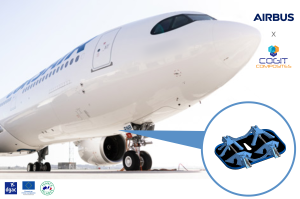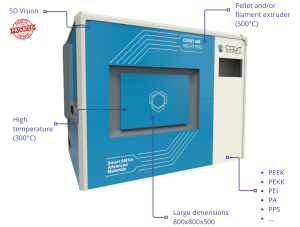Cogit JEC article 3D printing PEEK
COGIT in the JEC Magazine
For the July and August issue, COGIT Composites has the pleasure to have an article in the JEC Magazine. This article is about how direct 3D printing of PEEK on aeronautical CFRP components can functionalize a composite structure without additional molds. This opens up new design opportunities.
Now here is an abreviated version of this article that you can fing here !
The ECHOS 2 project, spearheaded by AIRBUS Atlantic and funded by DGAC under the FRANCE Relance 2030 initiative, marks a significant leap forward in aerospace technology. This project aims to innovate the manufacturing of aircraft components through advanced composite materials and 3D printing. COGIT Composites, a key player in this venture, has focused on developing a new hybrid technology that integrates short fiber additions to CFRP (Carbon Fibre Reinforced Polymer) composites, optimizing both weight and cost of airplane access doors.
Lightweight and Cost-Effective Innovation
In collaboration with AIRBUS Atlantic, COGIT Composites has reimagined the aircraft access door located under the cockpit. By employing CFRTP (Carbon Fibre Reinforced Thermoplastic Polymer) and advanced 3D printing techniques, the team aims to add functional enhancements and structural reinforcements directly onto CFRP components. This process not only eliminates the need for additional molds but also allows for greater flexibility and efficiency in manufacturing.

Mastering 3D Printing of PEEK/Carbon Fiber
A significant aspect of the project involves the meticulous study of the mechanical integrity of parts entirely printed from PEEK (Polyether Ether Ketone) with short carbon fibers. The FFF (Fused Filament Fabrication) method layers molten polymer, creating potential weak spots at the interfaces. Given the semi-crystalline nature of PEEK and PEKK (Polyether Ketone Ketone), numerous complex interactions occur at these interfaces, affecting the coalescence, molecular inter-diffusion, crystallization, and healing of the material.

Experimental studies have identified optimal FFF parameters, notably maintaining the thermal chamber temperature between 270°C and 300°C, ensuring high mechanical performance of the printed interfaces, achieving strength up to 95 MPa. These findings support the reliability and repeatability of 3D printed PEEK/carbon fiber parts.
Ensuring Strong Interfaces Between Composite Layers
Beyond mastering the quality of fully printed parts, the project also emphasizes the integrity of the interface between the CFRP composite and the printed PEEK/carbon fiber components. A specialized test specimen and protocol were developed to evaluate the adhesion strength in shear and pull-off tests. This step ensures that the aerodynamic external composite skin effectively transfers loads to the internal structural layers.
Maintaining the material health of the composite during this process is critical. Excessive processing parameters can lead to local deconsolidation, introducing inter-laminar defects detrimental to the structure’s integrity. Thorough experimental planning helps identify parameters that ensure robust bonding at the composite-printed interface.
Topological Optimization and Hybrid Design
Armed with mechanical characterization data of both fully printed zones and composite-printed interfaces, the team employs topological optimization using finite element models. This allows them to predefine the shapes and thicknesses necessary to withstand various loading scenarios, from in-flight pressure differentials to emergency landing conditions. The design is refined to accommodate the specific constraints of the FFF process, ensuring minimal support structures are needed.
Cutting-Edge 3D Printing Equipment
The project utilizes the COGIT AM 885 HT Pro printer, renowned for its advanced capabilities in handling high-performance polymers and composites. This machine’s thermally regulated chamber, capable of reaching 300°C, and its large build volume make it ideally suited for producing the ECHOS 2 project’s door prototype.

Prototype Manufacturing and Quality Control
After validating the design and methodology, the prototype’s geometry is sliced into a G-Code program, guiding the layer-by-layer deposition of PEEK. Specific printing parameters are fine-tuned through tests on smaller sections of the piece. An innovative in-situ control system using thermal cameras monitors the real-time deposition process, identifying potential defects immediately. This system, combined with conventional X-ray tomography, ensures the robustness and quality of the printed parts.
Conclusion and Future Prospects
The 3/5 scale prototype showcased at JECWORLD 2024 demonstrates the success of the ECHOS 2 project and the collaborative efforts with AIRBUS Atlantic. Key technological advancements, such as optimizing 3D printing parameters for PEEK, managing composite interfaces, and integrating thermographic control, have been achieved. This hybrid composite technology holds great potential for future aerospace applications, enabling more efficient and functional component designs.
COGIT Composites, with its 20-year expertise in thermoplastic composites, continues to lead in innovation, supporting diverse industrial projects and seeking further collaborative opportunities to advance this promising technology.
You liked this article? Read the complete vernsion on the JEC Magazine !
